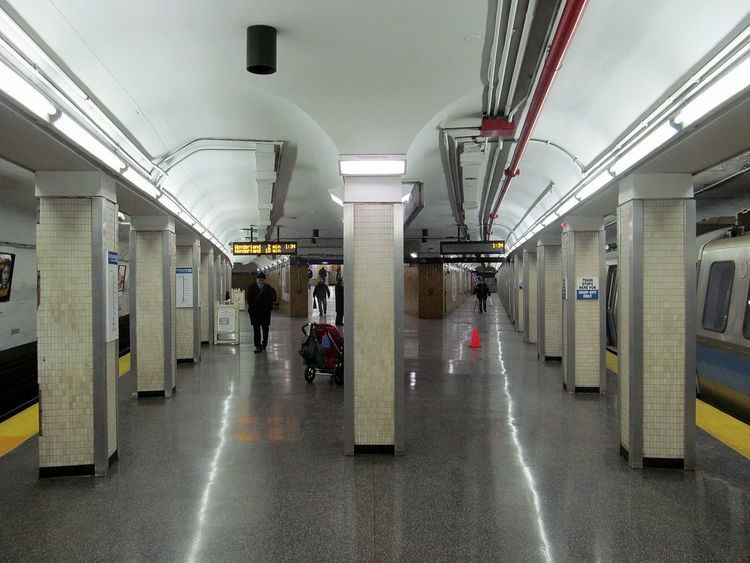Line(s) Blue Line Opened 18 March 1916 Tracks 2 | Connections MVRTA: Boston Commuter Phone +1 617-222-3200 | |
 | ||
Location Cambridge Street at New Chardon and Bowdoin Streets
Boston, Massachusetts Owned by Massachusetts Bay Transportation Authority Platforms 1 wedge-shaped island platform Closed January 3, 1981 - January 11, 1982
March 3, 1982 - April 20, 1982 Address Boston, MA 02114, United States Owner Massachusetts Bay Transportation Authority Connection Merrimack Valley Regional Transit Authority Similar Government Center, Wonderland, Charles/MGH, Maverick, Suffolk Downs | ||
Bowdoin (/ˈboʊdᵻn/) is a rapid transit station on the MBTA Blue Line, located in Bowdoin Square in the Beacon Hill neighborhood of Boston, Massachusetts. It is the downtown terminus of the line (though Government Center served this role during nights and weekends from 1982 to 2014).
Contents
Bowdoin station is not handicapped accessible due to the tight dimensions of the 1916-built station. Bowdoin and Wollaston are the only heavy rail MBTA stations that are not accessible.
History
The East Boston Tunnel was opened to streetcar service as far as Court Street on December 30, 1904. Court Street proved to be a problematic terminus; its single-track design limited frequent service, and also resulted in crashes. The Boston Elevated Railway (BERy) began an extension towards Beacon Hill in 1912. The extension opened to Bowdoin with an intermediate stop at Scollay Under on March 18, 1916.
Bowdoin was built with an unusual wedge-shaped island platform inside a balloon loop, which eliminated the awkward end-changing required at Court Street and allowed use of unpowered trailer cars in the tunnel to increase capacity. A pair of tracks continued past the loop, out the Joy Street Portal, and down Cambridge Street, allowing for one route to provide through streetcar service from East Boston to Cambridge rather than looping at Bowdoin.
Over the weekend of April 18 to 21, 1924, the East Boston Tunnel was converted from streetcar use to high-floor rapid transit operation. Rather than modify the tunnel, the BERy elected to build smaller-than-usual rapid transit cars which could operate in a tunnel designed for streetcars—particularly around the tight loop at Bowdoin. Blue Line cars are thus 48.5 feet (14.8 m) long, substantially shorter than the 65-foot (20 m) Orange Line cars and the 69.5-foot (21.2 m) Red Line cars. Bowdoin is the only remaining loop in regular service on the MBTA's heavy rail lines, though Red Line trains can loop around Codman Yard past Ashmont station if necessary.
Because the line did not have a dedicated maintenance facility, trains used the Joy Street Portal to reach surface tracks on the Longfellow Bridge, which connected to the Cambridge Tunnel and the Eliot Shops near Harvard Square. When the first phase of the Revere Extension opened to Orient Heights with a new facility in 1952, the connection was no longer necessary and the portal was filled. The tail tracks past the Bowdoin loop are still used for train storage during the winter, however.
The station was modernized in 1968 as part of a $9 million systemwide station improvement program. The original headhouse was replaced with a glassy entrance under a tilted concrete slab, set into a shallow depression to reduce the costs of installing the escalator. The new headhouse was designed by Josep Lluís Sert as part of a project for a never-built Catholic chapel nearby.
In the early 1980s, the MBTA suffered from a serious budget crisis, which resulted in service cuts. MBTA Commuter Rail service to Providence and Concord and on the Woburn Branch were cut entirely, five underused commuter rail stations were closed, Boylston and Essex were closed for short periods, and the outer ends of the Orange and Blue lines were bustituted on Sundays. Bowdoin, with low ridership and in close proximity to Government Center, was closed on January 3, 1981. It reopened on January 11, 1982, but only on weekdays until 6:30 pm - intended to serve workers in nearby office and government buildings. Bowdoin was briefly closed again from March 3 to April 20, 1982, and reopened again with limited hours, with Government Center serving as the terminus on nights and weekends (though trains continued to loop at Bowdoin).
In 2008, the MBTA started running a mixture of 4-car and 6-car trains on the Blue Line, adding more long trains as new cars arrived from the manufacturer. Incoming 6-car trains can fit on the westbound platform where trains go out of service, but only 4-car trains can fit on the eastbound side where trains come into service after turning around. At Bowdoin only, passengers must press a "door open" button mounted on the train exterior to board a 6-car train.
Bowdoin station is currently open for all hours of service, including on weekends, from December 28, 2013 onwards during the closure of the Callahan Tunnel and Government Center Station. In February 2016, the MBTA announced that Bowdoin would remain open at all times even after Government Center reopened on March 21.
Bus connections
Bowdoin has no regular MBTA Bus connections. Both MVRTA Boston Commuter routes (Methuen-Lawrence-Andover-Boston and North Andover-Boston) stop on Cambridge Street across from the station.
